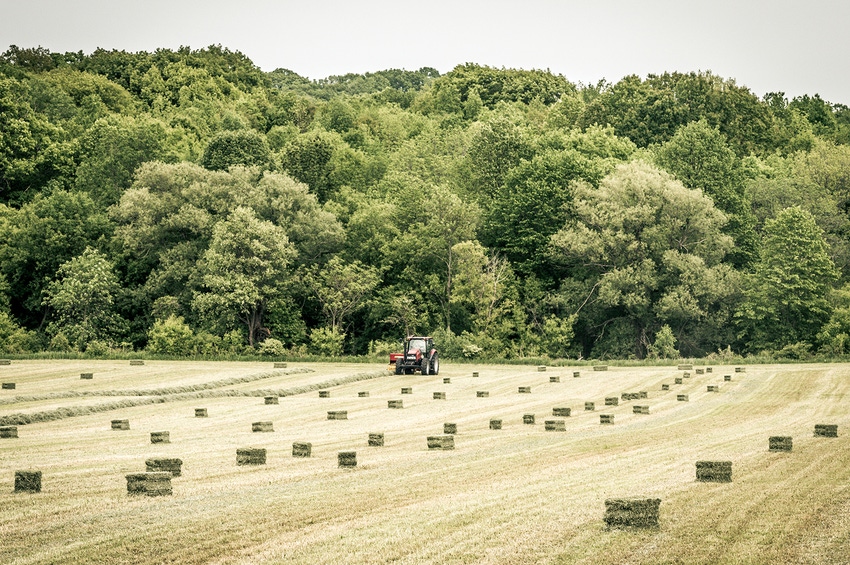February 3, 2021

When livestock producers buy hay, they usually think in terms of how many tons they need to feed their livestock through the winter, Dr. David Fernandez, Extension livestock specialist and interim dean of graduate studies for the University of Arkansas at Pine Bluff, said. Few producers think of hay in terms of the pounds of nutrients that hay will provide.
“Some producers may think it is good enough to make sure their animals have something to eat – that anything will suffice,” he said. “But you will not be meeting your animals’ nutritional needs by feeding them 33 pounds of pine straw per day.”
Getting a hay analysis
The key for producers to know how many nutrients they are buying is having their hay tested. Hay testing is easy. Simply take a core sample from several of your bales using a hay probe. In Arkansas, county Extension offices can provide hay probes.
When collecting hay for testing, keep the following tips in mind:
Gather about a quart-sized bag-full of hay for submission.
The hay should come from more than one bale.
Keep the sample out of the sun so the forage in the sample does not become bleached or “cooked” on the dashboard.
Take the sample to your local Extension office and request a hay analysis. The cost for the analysis is $18.
For more details about how to test your hay, ask a local Extension agent for the publication “FSA 3114: Test Hays for Nutrient Composition Before Feeding” by Dr. Shane Gadberry and Mark Keaton.
Interpreting the results
The analysis shows how many pounds of nutrients are in each ton of hay. Producers need to interpret the results keeping in mind the nutritional needs of their individual animals to see if they bought enough nutrients.
Dr. Fernandez said producers are typically most concerned with total digestible nutrients (TDN), a measurement of the energy in the feed and crude protein (CP). A 1,100-pound pregnant cow will need about 11 pounds of TDN and 1.5 pounds of CP each day.
“Suppose your hay analysis comes back and your hay is 60% TDN and 9% CP. In this case, if your cow eats roughly 25 pounds of hay each day, she will get 13.2 pounds of TDN and 1.98 pounds of CP,” he said. “Your hay will more than meet her needs.”
But what if your hay analysis comes back with 45% TDN and 6% CP? The cow will only receive 9.9 pounds of TDN and 1.32 pounds of CP – not enough to meet her needs.
“You may have paid the same amount of money for each ton of hay, but you clearly did not buy as many nutrients in the second example,” Dr. Fernandez said.
Supplementing hay
“If you are feeding livestock poor quality hay like that from the second example, you will have to supplement your livestock with grain, pellets or cubes,” Dr. Fernandez said. “A cow consuming this hay will need an extra 1.1 pounds of TDN and a quarter of a pound of CP each day to meet her needs.”
To learn more about how to substitute supplements for hay, ask a local Extension agent for the publication “FSA 3036: Substituting Grain for Hay in Beef Cow Diets” by Dr. Shane Gadberry and Dr. Paul Beck.
Cut feeding bills
To save on feeding bills, producers who planted cool season annuals in the fall can supplement their animals’ diet with these pastures, which can be used in the early winter, Dr. Fernandez said. Cool season annuals are very nutritious.
“Using stockpiled forages and cool season annuals can greatly reduce your feed costs and improve the quality of your animals’ nutrition, reducing costs and increasing performance, “ he said. “Once stockpiled forage is gone, you can move your animals to the cool season annual pasture. The greatest advantage to cool season annuals is in the early spring, when they grow rapidly to provide plenty of high-quality forage before your warm season grasses break dormancy.”
Dr. Fernandez said livestock can become overly fat if they are allowed continuous access to high quality cool season annual pastures.
“You may have to limit their access to the pasture and provide some lower quality hay upon which they can fill up, he said. “Once the weather warms and your warm season grasses are ready to begin growing, you will have to mow, spray or graze down the cool season annuals so your warm season grasses can grow.”
For more information on this or other livestock topics contact Dr. Fernandez at (870) 575-8316 or [email protected].
The University of Arkansas at Pine Bluff offers all of its Extension and Research programs and services without regard to race, color, sex, gender identity, sexual orientation, national origin, religion, age, disability, marital or veteran status, genetic information, or any other legally protected status, and is an Affirmative Action/Equal Opportunity Employer.
Source: University of Arkansas, which is solely responsible for the information provided and is wholly owned by the source. Informa Business Media and all its subsidiaries are not responsible for any of the content contained in this information asset.
You May Also Like




